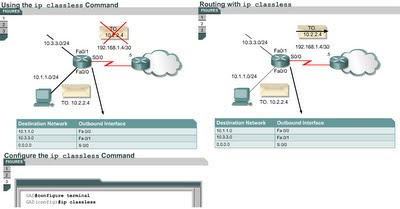Common RIP configuration issues
7.2.4
This page will provide some more information about the methods that are used to reduce routing loops.RIP routers must rely on neighbor routers for some types of network information. A common term used to describe this functionality is Routing by Rumor. RIP uses a distance vector routing algorithm. All distance vector routing protocols have issues that are primarily created by slow convergence. Convergence is when all routers in a network have the same routing information.
Among these issues are routing loops and counting to infinity. These result in inconsistencies due to update messages with incorrect routes that are propagated around the network.
To reduce routing loops and counting to infinity, RIP uses the following techniques:
- Split horizon
- Poison reverse
- Holddown counters
- Triggered updates
RIP permits a maximum hop count of 15. Any destination greater that 15 hops away is tagged as unreachable. This maximum hop count greatly restricts the use of RIP in large internetworks but prevents counts to infinity and endless network routing loops.
The split horizon rule is based on the theory that it is not useful to send information about a route back in the direction from which it came. In some network configurations, it may be necessary to disable split horizon.
The following command is used to disable split horizon:
GAD(config-if)#no ip split-horizon
The holddown timer is another mechanism that may need to be configured. Holddown timers help prevent counting to infinity but also increase convergence time. The default holddown for RIP is 180 seconds. This will prevent any inferior route from being updated but may also prevent a valid alternative route from being installed. The holddown timer can be decreased to speed up convergence but should be done with caution. Ideally, the timer should be set just longer than the longest possible update time for the internetwork. In the example in Figure Use the following command to change the holddown timer as well as the update, invalid, and flush timers:
Router(config-router)#timers basicupdate invalid holddown flush [sleeptime ]
Another configurable item that affects convergence time is the update interval. The default RIP update interval in Cisco IOS is 30 seconds. This can be configured for longer intervals to conserve bandwidth, or for shorter intervals to decrease convergence time.Another issue with routing protocols is the unwanted advertisement of routing updates out a particular interface. When a network command is issued for a given network, RIP will immediately begin to send advertisements out all interfaces within the specified network address range. A network administrator can use the passive-interface command to disable routing updates on specified interfaces.
Because RIP is a broadcast protocol, the network administrator may have to configure RIP to exchange routing information in a non-broadcast network such as Frame Relay. In this type of network, RIP must be informed of neighbor RIP routers. To do this use the neighbor command displayed in Figure
By default, the Cisco IOS software receives RIP Version 1 and Version 2 packets, but sends only Version 1 packets. The network administrator can configure the router to only receive and send Version 1 packets or the administrator can configure the router to send only Version 2 packets. To configure the router to send and receive packets from only one version, use the commands in Figure
To control how packets received from an interface are processed, use the commands in Figure
The next page will show students how to verify a RIP configuration.




